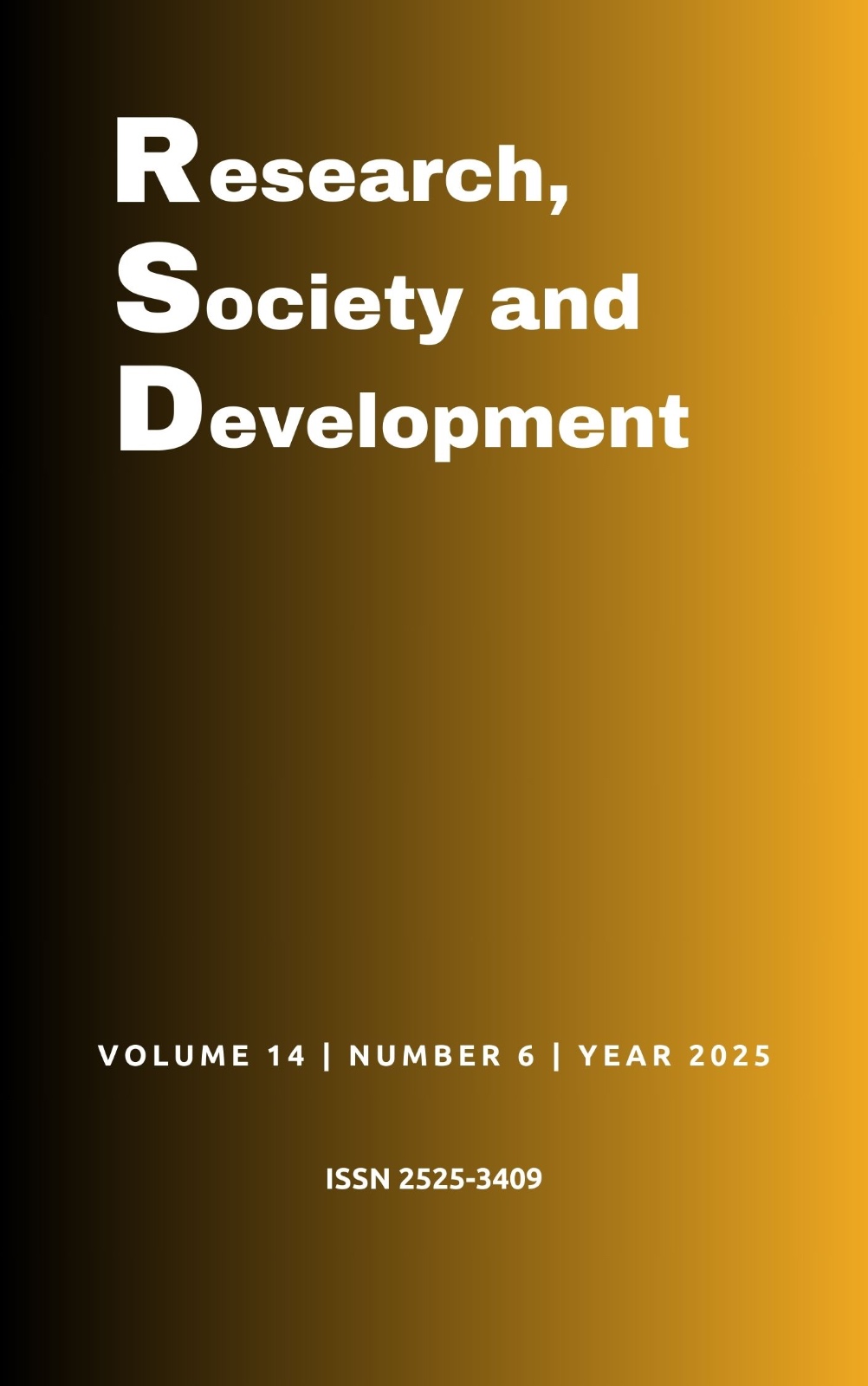Fixed-time artificial insemination and early pregnancy diagnosis in dairy cows: A literature review
DOI:
https://doi.org/10.33448/rsd-v14i6.48990Keywords:
Diagnosis, Insemination, Reproduction.Abstract
Fixed-time artificial insemination and early pregnancy diagnosis have been widely used in dairy farming as strategies to increase reproductive efficiency and optimize herd productivity. The use of these technologies allows for the control of ovulation timing and rapid pregnancy detection, promoting better organization of livestock management and reducing the calving interval. These advances are particularly important on farms where estrus detection is limited and in production systems seeking more consistent results in the short and medium term. Based on this context, the general objective of this research was to evaluate, through a literature review, the effectiveness of fixed-time artificial insemination and early pregnancy diagnosis in the reproduction of dairy cows, considering factors that directly affect the outcomes of these procedures, such as nutrition, health, and genetics. The adopted methodology was based on a qualitative literature review conducted from 2021 to 2025, using databases such as Lilacs, Capes Journals, Google Scholar, and Scielo. Only studies that focused on dairy cows, were available in full text, and peer-reviewed were included. As a result, it was found that FTAI protocols, when properly applied and combined with effective diagnostic methods such as Doppler ultrasonography and gene expression tests, favor an increase in pregnancy rates, reduce gestational losses, and allow rapid resynchronization of non-pregnant cows. Nutritional, health, and genetic factors were decisive for the success of the analyzed techniques. The research also highlighted the importance of complying with legislation and having qualified technical professionals conduct reproductive programs.
Downloads
References
Brasil. (1968, outubro 23). Lei nº 5.517, de 23 de outubro de 1968: Dispõe sobre o exercício da profissão de Médico Veterinário e cria os Conselhos de Medicina Veterinária. https://www.planalto.gov.br/ccivil_03/leis/l5517.htm
Brasil. (1998, fevereiro 12). Lei nº 9.605, de 12 de fevereiro de 1998: Dispõe sobre as sanções penais e administrativas derivadas de condutas e atividades lesivas ao meio ambiente. https://www.planalto.gov.br/ccivil_03/leis/l9605.htm
Carvalho, V. H. G., & Vieira, P. R. P. (2023). Melhoramento genético como estratégia de avanço da produção e da produtividade durante o confinamento bovino. Scientia Generalis, 4(1). http://www.scientiageneralis.com.br/index.php/SG/article/view/477
Dias, T. M. S., & Cardoso, C. F. S. (2021). Determinação do nível de perfusão ovariana no diagnóstico precoce de prenhez em vacas. SEMINFO 2021 (Volume II), 6. https://repositorio.ifgoiano.edu.br/bitstream/prefix/2381/1/Anais%20da%20XIV%20Semana%20de%20Inform%C3%A1tica.pdf#page=12
Freitas, E. M., et al. (2021). Utilização das proteínas associadas à gestação (PAG’s-Bovine Pregnancy Test Idexx®) como método de diagnóstico precoce de gestação em vacas leiteiras da raça girolando. Research, Society and Development, 10(2), e41410212807. https://rsdjournal.org/index.php/rsd/article/view/12807
Guerra, A. C., Ferraz, P. A., & Pugliesi, G. (2021). Expressão de genes estimulados por interferon-tau para diagnóstico precoce da gestação em novilhas e vacas leiteiras. 29º SIICUSP: Resumos. https://repositorio.usp.br/bitstreams/677f6b6d-aaa5-4905-8dc2-4f0092655aa3
Laurindo Neto, A. (2022). Impactos da antecipação da ressincronização da ovulação pela detecção precoce de vacas leiteiras não gestantes com a ultrassonografia Doppler [Tese de doutorado, Universidade de São Paulo].
https://www.teses.usp.br/teses/disponiveis/10/10131/tde-12122022-120917/?gathStatIcon=true
Lemes, B. C., et al. (2022). Metodologia e manejo reprodutivo aplicado em bovinos leiteiros. Revista Agroveterinária do Sul de Minas, 4(1), 153–172. https://periodicos.unis.edu.br/agrovetsulminas/article/view/741
Lima, A. C. N., et al. (2022). Perdas reprodutivas e reconcepção em fêmeas bovinas de corte submetidas a inseminação artificial em tempo fixo. Ciência Animal Brasileira, 23, e70384. https://www.scielo.br/j/cab/a/WgRkt7zvKt7Ntf7FpdDPCsd/?lang=pt
Lima, T. C. S., & Mioto, R. C. T. (2007). Procedimentos metodológicos na construção do conhecimento científico: a pesquisa bibliográfica. Revista Katálysis, 10(esp), 37–45. https://www.scielo.br/j/rk/a/HSF5Ns7dkTNjQVpRyvhc8RR/?format=pdf
Melo, J. R. S., et al. (2021). Uso da IATF em pequenos rebanhos leiteiros como experiência de extensão rural no estado do Maranhão. Ciência Animal, 31(1), 45–48. https://revistas.uece.br/index.php/cienciaanimal/article/view/9576
Nascimento, G. V., et al. (2022). Desempenho reprodutivo de um rebanho Curraleiro Pé-Duro no semiárido da Paraíba. REVINSA - Revista do Instituto Nacional do Semiárido, 1(3), 43–48. https://www.editoraverde.org/portal/revistas/index.php/revinsa/article/view/187
Pinto, L. M. F., Pugliesi, G., & Ferraz, P. A. (2021). Acurácia do uso da expressão de genes estimulados por interferon-tau comparado à ultrassonografia Doppler para diagnóstico precoce de gestação em novilhas e vacas leiteiras. 29º SIICUSP: Resumos.
https://repositorio.usp.br/bitstreams/4dccdca3-80ee-480b-90a3-d4197155439c
Silva, M. A. N., Mello, M. R. B., & Palhano, H. B. (2021). Inseminação artificial e inseminação artificial em tempo fixo em bovinos. Revista Científica do UBM, 79–97. http://revista.ubm.br/index.php/revistacientifica/article/view/1039
Downloads
Published
Issue
Section
License
Copyright (c) 2025 Guilherme de Campos Ferreira; Taisa Fernanda Conceição Santos Limberger

This work is licensed under a Creative Commons Attribution 4.0 International License.
Authors who publish with this journal agree to the following terms:
1) Authors retain copyright and grant the journal right of first publication with the work simultaneously licensed under a Creative Commons Attribution License that allows others to share the work with an acknowledgement of the work's authorship and initial publication in this journal.
2) Authors are able to enter into separate, additional contractual arrangements for the non-exclusive distribution of the journal's published version of the work (e.g., post it to an institutional repository or publish it in a book), with an acknowledgement of its initial publication in this journal.
3) Authors are permitted and encouraged to post their work online (e.g., in institutional repositories or on their website) prior to and during the submission process, as it can lead to productive exchanges, as well as earlier and greater citation of published work.


